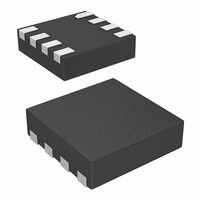ISL9211IRU68XZ-T Intersil, ISL9211IRU68XZ-T Datasheet - Page 7

ISL9211IRU68XZ-T
Manufacturer Part Number
ISL9211IRU68XZ-T
Description
IC SAFETY CIRCUIT CHARGE 8-TDFN
Manufacturer
Intersil
Datasheet
1.ISL9211IRU68XZ-T.pdf
(9 pages)
Specifications of ISL9211IRU68XZ-T
Function
Battery Monitor
Battery Type
Lithium-Ion (Li-Ion)
Voltage - Supply
4.3 V ~ 24 V
Operating Temperature
-40°C ~ 85°C
Mounting Type
Surface Mount
Package / Case
8-µTDFN
Lead Free Status / RoHS Status
Lead free / RoHS Compliant
Other names
ISL9211IRU68XZ-TTR
that of the sensing FET. The comparator CP2 then outputs a
signal to turn off the power FET.
The OCP threshold can be calculated using Equation 1:
where the 0.8V is the regulated voltage at the ILIM pin. The
OCP comparator CP2 has a built-in 170µs delay to prevent
false triggering by transient signals. The OCP function also
has a 4-bit binary counter that accumulates during an OCP
event. When the total count reaches 8, the power NFET is
turned off permanently until the input power is recycled or
the enable pin is toggled. Figures 8 and 9 illustrate the
waveforms during the power-up when the output is shorted
to ground.
Internal Over-Temperature Protection
The ISL9211 monitors its own internal temperature to
prevent thermal failures. When the internal temperature
reaches +150°C, the IC turns off the N-channel power
MOSFET. The IC does not resume operation until the
internal temperature drops below +110°C.
Fault Indication Output
The FAULT pin is an open-drain output that indicates a LOW
signal when any of the three fault events happens. This
provides a signal to the microprocessor to take further action
to enhance the safety of the charging system.
Applications Information
The ISL9211 is designed to meet the “Lithium-Safe” criteria
when operating together with a qualified Li-ion battery
charger. The “Lithium-Safe” criteria requires the charger
output to fall within the green region shown in Figure 15
under normal operating conditions and NOT to fall in the red
region when there is a single fault in the charging system.
Taking into account the safety circuit in a Li-ion battery pack,
the charging system is allowed to have two faults without
creating hazardous conditions for the battery cell. The output
of the Li-ion charger, such as the ISL6292, ISL6292C, has a
typical I-V curve shown with the blue lines under normal
operation, which is within the green region. The function of
the ISL9211 is to add a redundant protection layer such that,
under any single fault condition, the charging system output
does not exceed the I-V limits shown with the red lines. As a
result, the charging system adopting the ISL9211 and the
ISL6292, ISL6292C chip set can easily pass the “Lithium-
Safe” criteria test procedures.
The ISL9211 is a simple device that requires only three
external components, in addition to the ISL6292 charger
circuit, to meet the “Lithium-Safe” criteria, as shown in the
“Typical Application Circuit” on page 1. The selection of the
current limit resistor R
(OCP)” on page 6.
I
LIM
=
--------------- 31250
R
0.8V
ILIM
⋅
=
ILIM
25000
--------------- -
R
ILIM
is given in “Overcurrent Protection
7
(EQ. 1)
ISL9211
R
The R
battery terminal, in case the ISL9211 fails. The
recommended value should be between 200kΩ to 1MΩ.
With 200kΩ resistance, the worst case current flowing from
the VB pin to the charger output is shown in Equation 2,
assuming the VB pin voltage is 24V under a failure mode
and the battery voltage is 4.2V.
Such a small current can be easily absorbed by the bias
current of other components in the handheld system.
Increasing the R
but at the same time increases the error for the 4.34V
battery OVP threshold.
The error of the battery OVP threshold is the original
accuracy at the VB pin given in the “Electrical Specifications”
table on page 2 plus the voltage built across the R
VB pin leakage current. The VB pin leakage current is less
than 20nA, as given in the “Electrical Specifications” table.
With the 200kΩ resistor, the worst-case additional error is
4mV and with a 1MΩ resistor, the worst-case additional error
is 20mV.
Capacitor Selection
The input capacitor (C
page 1) is for decoupling. Higher value reduces the voltage
drop or the overshoot during transients.
Two scenarios can cause the input voltage overshoot. The
first one is when the AC adapter is inserted live (hot
insertion) and the second one is when the current in the
power NFET of the ISL9211 has a step-down change.
Figure 16 shows an equivalent circuit for the ISL9211 input.
The cable between the AC/DC converter output and the
handheld system input has a parasitic inductor. The parasitic
resistor is the lumped sum of various components, such as
the cable, the adapter output capacitor ESR, the connector
contact resistance, and so on.
(
24V 4.2V
1000
VB
–
Selection
0
FIGURE 15. LITHIUM-SAFE OPERATING REGIONS
VB
prevents a large current from the VB pin to the
)
⁄
(
200kΩ
1
ISL9211
LIMITS
ISL6292C
LIMITS
VB
value reduces the worst case current,
)
=
1
2
in the “Typical Application Circuit” on
99μA
BATTERY VOLTAGE (V)
3
4
January 13, 2009
5
VB
by the
FN6658.4
(EQ. 2)
6









